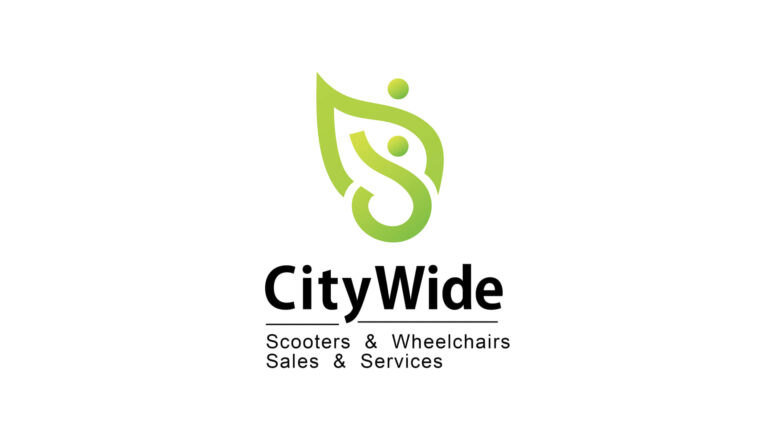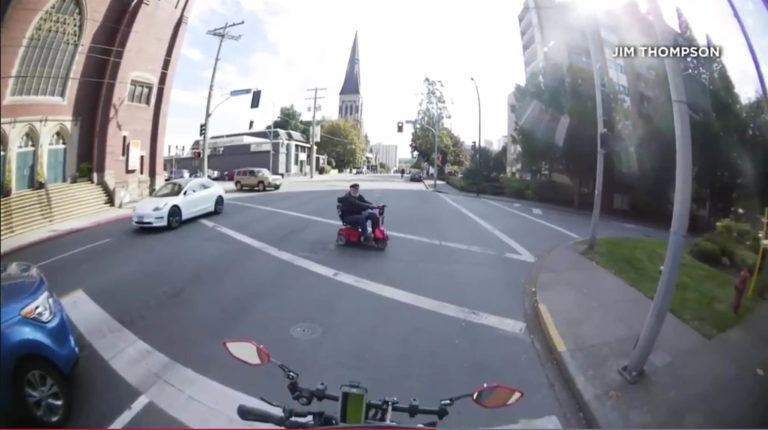Safety Tips for Mobility Scooters
— The article was published on Victoria.ca, the website of City of Victoria.
Safe choices begin with your choice of scooter
Before buying a scooter, check with an occupational therapist or physiotherapist to ensure that the model you select best meets your needs. Most suppliers will bring different scooters to you so that you can try them before making your purchase. Three-wheel scooters are designed for maximum manoeuvrability and are mainly used indoors. Four-wheel models are more stable and recommended for outdoor use where you are likely to encounter uneven terrain.
Considerations when purchasing your scooter
Before you purchase a scooter, consider the following elements:
• Size: Consider ease of operation, turning ability, suitability of the wheel size for the terrain you will be travelling on (indoors, outdoors or both), the size of elevator doors and the width of hallways and doorways at the places you travel frequently.
• Power: How far can you travel before the battery needs re-charging?
• Braking System: How long does it take to stop the scooter?
• Parking/Storage: Where will the scooter be stored? Is there an electrical outlet available in the storage area for charging your scooter?
Transporting your scooter
It is important to choose a scooter that can be transported easily. Ask the vendor the following:
• Can it be transported by car, van or taxi? • Does it require disassembling in order to be transported in the trunk of a vehicle?
• Is it transportable by transit or HandyDART? The maximum outside dimensions recommended by BC Transit are: Length:
122 cm (48 in) Width:
61 cm (24 in) Weight:
364 kg (600 lbs)
• Does it have anchors so it can be tied down in a taxi, transit bus or HandyDART vehicle? Want to practice getting on the bus with your scooter? HandyDART offers training sessions for using your scooter or other mobility aid.
Learn to use your scooter
It is essential to know how to operate your scooter before venturing out into the public. Begin by practicing in a quiet parking lot. Once you feel comfortable, find a friend who will travel with you on foot or scooter for your first few trips. Make sure you read the manual and any other safety information that may be supplied with your scooter.
Obey traffic rules for pedestrians
A person using a motorized scooter is classified as a pedestrian. When you are operating your scooter on a roadway, you must obey all the rules for pedestrians such as:
• Use sidewalks wherever possible. If there are no sidewalks or if sidewalks do not have scooter accessible curb cuts, travel on the far left side of the road facing traffic.
• Cross at pedestrian crosswalks. Come to a full stop and check for traffic before crossing.
• If there is no crosswalk available, stop, look both ways, and proceed only when all approaching vehicles have come to a full stop.
• Make eye contact with motorists and pedestrians and confirm their intention to stop before crossing their path.
• Obey all traffic control signs and devices.
• Operation of scooters in bicycle lanes is prohibited.
Be a courteous pedestrian
• Keep to the right of the sidewalk and travel at the same speed as pedestrians. Avoid travelling too closely behind or obstructing them. If passing slower moving pedestrians avoid using your horn and ask people to let you pass.
• If you meet a friend on the sidewalk, pull to the side to let other pedestrians pass.
• Use caution when crossing store fronts. Be aware of pedestrians who could walk into you as they are leaving the building.
Practice safety at ramps and curb cuts
Take curb cuts, driveways and ramps head on and always drive on the most level area of the curb cut, even if it means moving outside of the crosswalk lines. Driving sideways on a curb cut puts you at risk of tipping over.
Know your area
Get familiar with the most navigable routes in your neighbourhood. Be aware of the locations of curbs that do not have curb cuts or streets that do not have sidewalks so you can avoid these routes.
Allow yourself plenty of time. You may need to take an alternative route if unforeseeable circumstances arise, such as closed sidewalks or construction.
Be visible
Be aware that when you are traveling by scooter you are at a height disadvantage to the other users of the road and sidewalk. Make sure you and your scooter have the following safety features:
• Brightly coloured and/or reflective clothing
• Reflective strips on front, sides and back of scooter
• Light on front of scooter
• Light on back of scooter
• Fluorescent orange bike flag attached to the back seat of the scooter
Be prepared for unexpected circumstances
Carry a cell phone and phone numbers in case you encounter unexpected circumstances.
In an emergency situation, attract the attention of passers-by and ask them to phone for help. Dial “911” for emergency assistance.
Accessible Transit Services
Two types of accessible transit service are offered in Victoria: door-to-door handyDART service and fixed route service. Fixed route service includes both low floor and lift-equipped community buses on fixed routes and schedules. Contact Victoria Regional Transit directly for more information.
www.transitbc.com/regions/vic/accessible
BC Transit Mobility Aid Orientation
250-385-2551
HandyDART Orientation
250-727-7881



